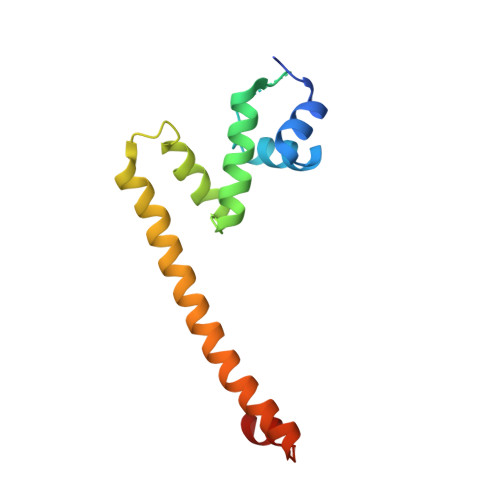Structural Analysis of the Hg(II)-Regulatory Protein Tn501 MerR from Pseudomonas aeruginosa.
Wang, D., Huang, S., Liu, P., Liu, X., He, Y., Chen, W., Hu, Q., Wei, T., Gan, J., Ma, J., Chen, H.(2016) Sci Rep 6: 33391-33391
- PubMed: 27641146
- DOI: https://doi.org/10.1038/srep33391
- Primary Citation of Related Structures:
5CRL - PubMed Abstract:
The metalloprotein MerR is a mercury(II)-dependent transcriptional repressor-activator that responds to mercury(II) with extraordinary sensitivity and selectivity. It's widely distributed in both Gram-negative and Gram-positive bacteria but with barely detectable sequence identities between the two sources. To provide structural basis for the considerable biochemical and biophysical experiments previously performed on Tn501 and Tn21 MerR from Gram-negative bacteria, we analyzed the crystal structure of mercury(II)-bound Tn501 MerR. The structure in the metal-binding domain provides Tn501 MerR with a high affinity for mercury(II) and the ability to distinguish mercury(II) from other metals with its unique planar trigonal coordination geometry, which is adopted by both Gram-negative and Gram-positive bacteria. The mercury(II) coordination state in the C-terminal metal-binding domain is transmitted through the allosteric network across the dimer interface to the N-terminal DNA-binding domain. Together with the previous mutagenesis analyses, the present data indicate that the residues in the allosteric pathway have a central role in maintaining the functions of Tn501 MerR. In addition, the complex structure exhibits significant differences in tertiary and quaternary structural arrangements compared to those of Bacillus MerR from Gram-positive bacteria, which probably enable them to function with specific promoter DNA with different spacers between -35 and -10 elements.
Organizational Affiliation:
Coordination Chemistry Institute and the State Key Laboratory of Coordination Chemistry, School of Chemistry and Chemical Engineering, Collaborative Innovation Center of Chemistry for Life Sciences, Nanjing University, Nanjing 210093, P. R. China.















